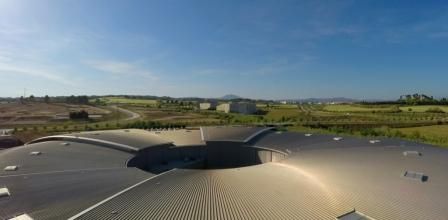
17/02/2016
Barcelona Synchrotron Park, a Park with a (Pre)History
Barcelona Synchrotron Park, a Park with a (Pre)History
By the end of January, the catalogue of the exhibition entitled Before Alba organized by the city council of Cerdanyola (where the Barcelona Synchrotron Park - BSP and ALBA synchrotron are located) and the Ca n’Oliver city museum was presented. It is published by the Barcelona Synchrotron Park.
This exhibition, which will travel throughout Catalonia from now on, presents the results of the archeological digs carried out around the synchrotron. These results give information about how human societies had been continuously living over millennia in the territory currently occupied by BSP or the campus of the Universitat Autònoma de Barcelona (UAB).
Archeological discoveries made over the past 30 years in the context of the economical development of this so-called del Vallès plain (construction of the Vallès Technology Park – PTV and then BSP, extension of the UAB campus...) range from the Paleolithic era to the Spanish Civil War (1936-1939) and bring us to a conclusion: if BSP aims at attracting innovative companies, women and men didn’t wait for BSP to innovate: for example, as Before Alba evidences, people from this territory invented centuries ago new ways to seal silos in order to preserve the stored seeds.
Different examples from these digs can be pointed out: flint tools from the Upper Paleolithic period (35,000-25,000 B.C.) near the UAB Mathematical Research Center, the pot from Neolithic period (4,000-3,800 B.C.) at the UAB sport center, the Bronze Age (1,800-750 B.C.) collective tomb discovered where the synchrotron is, 12th century silos o German bombs from the Spanish Civil War at PTV.
“Time is present in motion” used to say the well-known Catalan paleontologist Miquel Crusafont. In this implacable dynamic process, Before Alba exhibition, to which BSP contributes, allows to go back in time and to put into perspective the here and now that are up to us to live out.
This exhibition, which will travel throughout Catalonia from now on, presents the results of the archeological digs carried out around the synchrotron. These results give information about how human societies had been continuously living over millennia in the territory currently occupied by BSP or the campus of the Universitat Autònoma de Barcelona (UAB).
Archeological discoveries made over the past 30 years in the context of the economical development of this so-called del Vallès plain (construction of the Vallès Technology Park – PTV and then BSP, extension of the UAB campus...) range from the Paleolithic era to the Spanish Civil War (1936-1939) and bring us to a conclusion: if BSP aims at attracting innovative companies, women and men didn’t wait for BSP to innovate: for example, as Before Alba evidences, people from this territory invented centuries ago new ways to seal silos in order to preserve the stored seeds.
Different examples from these digs can be pointed out: flint tools from the Upper Paleolithic period (35,000-25,000 B.C.) near the UAB Mathematical Research Center, the pot from Neolithic period (4,000-3,800 B.C.) at the UAB sport center, the Bronze Age (1,800-750 B.C.) collective tomb discovered where the synchrotron is, 12th century silos o German bombs from the Spanish Civil War at PTV.
“Time is present in motion” used to say the well-known Catalan paleontologist Miquel Crusafont. In this implacable dynamic process, Before Alba exhibition, to which BSP contributes, allows to go back in time and to put into perspective the here and now that are up to us to live out.
More news
14/12/2018
The Open Innovation Forum matches business challenges to academic solutions
07/12/2018
2017 BioCat report: The best of the Bioregion of Catalonia
30/11/2018
Barcelona Synchrotron Park’s Commitment to Sustainable Growth
23/11/2018
Astronomers led by IEEC reveal a cold super-Earth around Barnard’s star
16/11/2018
CRAG’s Researchers discover how to generate plants with enhanced drought resistance
08/11/2018
The Barcelona manifesto: for a city-led science and technology diplomacy









